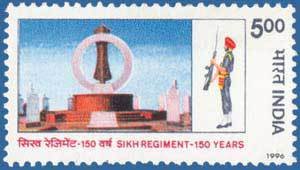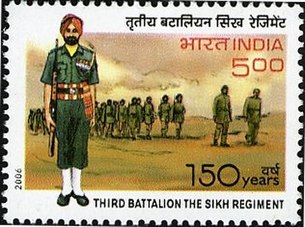Sikh Regiment
This article needs additional citations for verification. (April 2019) |
| Sikh Regiment | |
|---|---|
 Cap badge of the Sikh Regiment | |
| Active | 1 August 1846 – present |
| Country | |
| Branch | |
| Type | Line Infantry |
| Role | Infantry |
| Size | 20 battalions |
| Garrison/HQ | Ramgarh Cantonment, Jharkhand |
| Motto(s) | Nische Kar Apni Jeet Karon (With determination, I will be triumphant). |
| War Cry | Bole So Nihal Sat Sri Akaal (Shout Aloud in Ecstasy, True is the Great Eternal God!) |
| Anniversaries | 12 September Battle of Saragarhi |
| Decorations |
|
| Commanders | |
| Colonel of the Regiment | Lt Gen P.G.K Menon ,AVSM [3] |
| Insignia | |
| Regimental Insignia | Lion, symbolic of the name (Singh) every Sikh carries, ringed by a chakra |

The Sikh Regiment is an
The modern Sikh Regiment traces its roots directly from the 11th Sikh Regiment of the British Indian Army. When transferred to the Indian Army like its sister regiments, the numeral prefix (in the case of the Sikh Regiment, 11) was removed and extra battalions were raised, transferred or disbanded to meet army needs. With a humble beginning of two battalions, today the fraternity has grown to a regiment of 19 regular infantry and two reserve battalions strong. The 6th battalion takes over as ceremonial battalion of President's palace of India.[7][8]
History
After the
As part of the British Indian Army, Sikh regiments fought in numerous wars all over the world, such as the
During the
Recruitment
Sikh regiment is a "single class" regiment.[12] Its soldiers are solely recruited from Jat Sikhs and its officers are non-Jat Sikhs.[13][14] They are trained at the Sikh Regimental Centre, currently located in Ramgarh Cantonment, Jharkhand. The war cry of the regiment, taken from Sikh scriptures, is Jo Bole So Nihal, Sat Sri Akal.[a]
Units

- 2nd Battalion
- 3rd Battalion
- 4th Battalion
- 5th Battalion
- 6th Battalion
- 7th Battalion
- 8th Battalion
- 10th Battalion
- 11th Battalion
- 13th Battalion
- 14th Battalion
- 16th Battalion
- 17th Battalion
- 18th Battalion
- 19th Battalion
- 20th Battalion
- 21st Battalion
- 22nd Battalion
- 23rd Battalion
- 24th Battalion
Territorial Army (TA) Units-
- 124 Infantry Battalion (TA) (Sikh) located at New Delhi
- 152 Infantry Battalion (TA) (Sikh) located at Ludhiana, Punjab
- 157 Infantry Battalion (TA) (Sikh) (Home and Hearth) BD Bari, Jammu and Kashmir
Others:
- 1st Battalion is now 4th Battalion, Mechanised Infantry Regiment
- 9th Battalion was disbanded in 1984
Battle honours and theatre honours
Battle honours

- Pre-Independence
- Lucknow 1857-58, 1 Sikh
- Arrah 1857, 3 Sikh
- Bihar 1857, 3 Sikh
- China 1860-62, 2 Sikh
- Ali Masjid 1878, 1 & 3 Sikh
- Ahmed Khel 1880, 2 Sikh
- Afghanistan 1878-79, 1 Sikh
- Afghanistan 1878-80, 2 & 3 Sikh
- Kandahar 1880, 2 Sikh
- Suakin 1885, 2 Sikh
- Tofrek 1885, 2 Sikh
- Manipur 1891, 4 Sikh
- Chitral 1895, 1 & 2 Sikh
- Samana 1897, 4 Sikh
- Saragarhi/Gulistan 1897, 36 Sikh
- Punjab Frontier1897, 2, 3, 4 & 35 Sikh (SRC)
- Malakand 1897, 3 & 35 Sikh (SRC)
- Tirah1897-98, 2 & 4 Sikh
- China 1900, 1 Sikh
- North-West Frontier1908, 3 Sikh
- World War I

- La Bassée 1914, 2 & 5 Sikh
- St-Julien1914, 2 & 5 Sikh
- Armentières 1914-15, 5 Sikh
- Auber 1914, 2 & 5 Sikh
- Givens 1914, 4 Sikh
- Tsingtao 1914, 4 & 5 Sikh
- Neuve Chapelle 1914-15, 2, 3 & 5 Sikh
- France and Flanders 1914-15, 2 & 5 Sikh
- Suez Canal 1914-15, 1 Sikh
- Festubert 1915, 2 Sikh
- Tigris 1916, 3 & 5 Sikh
- Pyres 1915, 2 & 4 Sikh
- Sari Bair 1915, 1 Sikh
- Helles 1915, 1 Sikh
- Krishna 1915, 1 Sikh
- Suva 1915, 1 Sikh
- Gallipoli1915, 1 Sikh
- Egypt1915, 1 Sikh
- Mesopotamia1916-18, 1, 3 & 4 Sikh
- Sharon 1918, 2 & 5 Sikh
- Palestine1918, 5 Sikh
- Baghdad 1916-18, 5 Sikh
- Kut 1917, 1, 3 & 5 Sikh
- Hai1917, 3 & 4 Sikh
- Megiddo 1918, 5 Sikh
- Persia1918, 4 Sikh
- Egypt1918, 2 & 3 Sikh
- Inter-War years
- North-West Frontier 1918-19, 5 Sikh
- Afghanistan 1919, 2 Sikh
- Palestine 1921, 5 Sikh
- Second World War


- Agordat 1940-41, 4 Sikh
- Keren 1941, 4 Sikh
- El Alamein 1940-43, 4 Sikh
- Omars 1941, 4 Sikh
- Kuantan 1941-42, 5 Sikh
- Niyor Kluang1941-42, 5 Sikh
- Mersa Matruh 1941-42, 2 Sikh
- Kota Bharu 1942, 5 Sikh
- North Arakan 1942-45, 1 Sikh
- Buthidaung 1942-45, 1 Sikh
- Coriano1943-45, 2 Sikh
- San Marino 1943-45, 2 Sikh
- Poggio San Giovanni 1943-45, 2 Sikh
- Monte Calvo 1943-45, 4 Sikh
- Kangla Tongbi 1944, 1 Sikh
- Gothic Line 1943-45, 4 Sikh
- Nyaung U Bridgehead 1945, 1 Sikh
- Irrawaddy River 1945, 1 Sikh
- Shandatgyi 1945, 1 Sikh
- Kama 1945, 1 Sikh
- Sittang 1945, 1 Sikh
- Post-Independence
Theatre honours
- Pre-Independence
- Post-Independence

- Jammu & Kashmir 1947-48, 1, 5, 7 & 16 Sikh
- Jammu & Kashmir 1965, 2, 3 & 7 Sikh
- Punjab 1965, 4 Sikh
- Sindh 1971, 10 Sikh
- Punjab 1971, 2 Sikh
- East Pakistan 1971, 4 Sikh
- Jammu & Kashmir 1971, 5 & 6 Sikh
- Kargil 1999, 8 Sikh
Operation Blue Star
About 5000 Sikh soldiers, some belonging to the regiment, mutinied after the storming of the Golden Temple by the Indian Army as part of Operation Blue Star in 1984.[15] The Sikh Regiment's 9th battalion was disbanded after a large number of its troops mutinied.[16]
Gallantry awards

The museum of the Sikh Regimental Centre displays a record of the Sikh Regiment in four halls viz.,
- The Religious/Motivational Hall
- The Hall of Heritage
- The Regimental Glory Hall
- The Peripheral Gallery
In all, the regiment has to its credit 1652 gallantry awards and honours including:
- 2 Param Vir Chakras
- 8 Maha Vir Chakras
- 64 Vir Chakras
- 4 Ashoka Chakras
- 14 Victoria Crosses
- 21 Indian Order of Merits
In addition it has also earned:
- 75 battle honours
- 38 theatre honours besides five COAS Unit Citations
Indian Order of Merit
21 soldiers of the 36th Sikhs were posthumously awarded the Indian Order of Merit for their actions in the Battle of Saragarhi in 1897:[17][18]
- Hav. Ishar Singh
- Nk. Lal Singh
- L/Nk.Chanda Singh
- Sep. Sundar Singh
- Sep. Ram Singh
- Sep. Uttar Singh
- Sep. Sahib Singh
- Sep. Hira Singh
- Sep. Daya Singh
- Sep. Jivan Singh
- Sep. Bhola Singh
- Sep. Narayan Singh
- Sep. Gurmukh Singh
- Sep. Jivan Singh
- Sep. Gurmukh Singh
- Sep. Ram Singh
- Sep. Bhagwan Singh
- Sep. Bhagwan Singh
- Sep. Buta Singh
- Sep. Jivan Singh
- Sep. Nand Singh
Victoria Cross
- Nk. Gian Singh, 11th Sikh Regiment (while serving in 15th Punjab Regiment)
- Nk. Nand Singh, 11th Sikh Regiment
Param Vir Chakra
- Lance Naik Karam Singh, 1 Sikh Regiment
- Subedar Joginder Singh, 1 Sikh Regiment
Ashok Chakra
- Subedar
- Havildar
- Havildar Joginder Singh[22]
Maha Vir Chakra
- Major Ajit Singh
- Sub. Ajit Singh
- Sep. Amar Singh
- Brigadier Joginder Singh Bakshi
- Major Amarjit Singh Bal
- Lieutenant Colonel Inderbal Singh Bawa
- Sub. Nand Singh
- Lieutenant Colonel Dewan Ranjit Rai
- Shanghara Singh
Vir Chakra
- Lieutenant General Harbaksh Singh
- Subedar Nirmal Singh (Posthumously)
- Subedar Karnail Singh (Posthumously)
- Sepoy Satpal Singh
- 2nd Lieutenant R S Nagar (16 Sikh Regiment)
- L/Nk Mohinder Singh (16 Sikh Regt)
Padma Vibhushan
- Lieutenant General Harbaksh Singh
Padma Bhushan
- Lieutenant General Harbaksh Singh
Padma Shri
- Subedar Kaur Singh (10 Sikh) Boxing
See also
Alliances
References
Notes
- ^ English: One will be blessed eternally who says that God is the ultimate truth
Citations
- ^ "Padma Awards" (PDF). Ministry of Home Affairs, Government of India. 2015. Retrieved 21 July 2015.
- ^ a b Aggarwal, Rashmi (January 0101). "Ashoka Chakra Recipients".
- ^ "Lt Gen Sanjay Kumar Jha is head of IMA". Archived from the original on 3 September 2017. Retrieved 29 December 2024.
- ^ "The Elite Sikh Regiment of the Indian Army". Archived from the original on 28 November 2010. Retrieved 2 November 2010.
- ^ "Story of the Sikh Regiment" (PDF). Sikh review. Archived from the original (PDF) on 18 July 2011. Retrieved 2 November 2010.
- ^ John Pike. "Army Equipment". Globalsecurity.org. Retrieved 1 September 2022.
- ^ "Sikh Regiment takes over ceremonial duties at Rashtrapati Bhavan". The Tribune.
- ^ "Sikh Regiment takes over ceremonial duties at Rashtrapati Bhavan". The Hans India. 28 November 2020. Retrieved 11 July 2021.
- ^ "No. 22176". The London Gazette. 24 August 1858. p. 3903.
- ^ Pandey, Geeta (5 December 2011). "India polo match honours Sikhs' 1897 Saragarhi battle". British Broadcasting Corporation. bbc.co.uk. Retrieved 19 July 2012.
- ^ "Defence of Srinagar 1947". Indian Defence Review. Archived from the original on 18 March 2016. Retrieved 3 April 2016.
- ISBN 978-0-674-72880-6.
Some regiments, such as the Sikh Regiment and Sikh Light Infantry, are "single class," and therefore recruit combat troops only from members of a specified class, such as Jat Sikhs and Mazhabi and Ramdasia Sikhs.
- JSTOR 2760119.
Moreover, with the exception of Gurkhas (recruited in Nepal), Sikhs remain the only community to have infantry regiments drawn exclusively from their own numbers: the Sikh Regiment (manned, though not officered, by high-caste Jat Sikhs) and the Sikh Light Infantry (manned entirely by Mazhabi, or Scheduled Caste, "untouchable" Sikhs.
- ISBN 978-0-81-532975-6.
For example, all the Sikh units in the Indian Army do not come from the same mother regiment. There are two regiments, the Sikh Infantry Regiment (composed of high caste Jat Sikhs) and the Sikh Light Infantry Regiment (composed of lower caste Mazbhi Sikhs).
- ^ "General Promises to Punish Sikh Mutineers". The New York Times. 2 July 1984.
- ^ "J&K: Lessons from 1984 unheeded". 22 August 2019. Retrieved 1 April 2021.
- ^ "No. 26937". The London Gazette. 11 February 1898. p. 863.
- ^ Regimental numbers from photo of Saragarhi memorial plaque
- ^ "Subedar Surinder Singh selected for posthumous Ashok Chakra". Rediff.com. Retrieved 6 October 2014.
- ^ "Havildar Bachittar Singh".
- ^ "Havildar Bachittar Singh Ashoka Chakra Recipient". 13 September 1948.
- ^ "JOGINDER SINGH| GALLANTRY AWARD".
Bibliography
- 1st King George V's own battalion,: The Sikh Regiment
- A Legacy of Valour - An Illustrated History of the Sikh Regiment (1846-2010). Ramgarh: The Sikh Regiment Officers' Association, 2011, ISBN 978-81-905619-7-6.
External links
 Media related to Sikh Regiment at Wikimedia Commons
Media related to Sikh Regiment at Wikimedia Commons- globalsecurity.org: The Sikh Regiment
- Bharat-Rakshak.com: The Sikh Regiment

